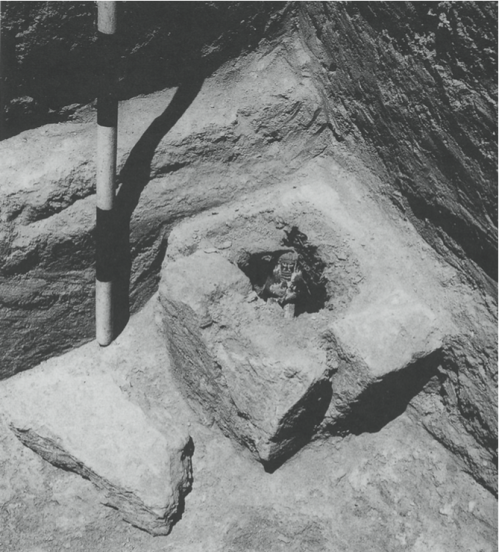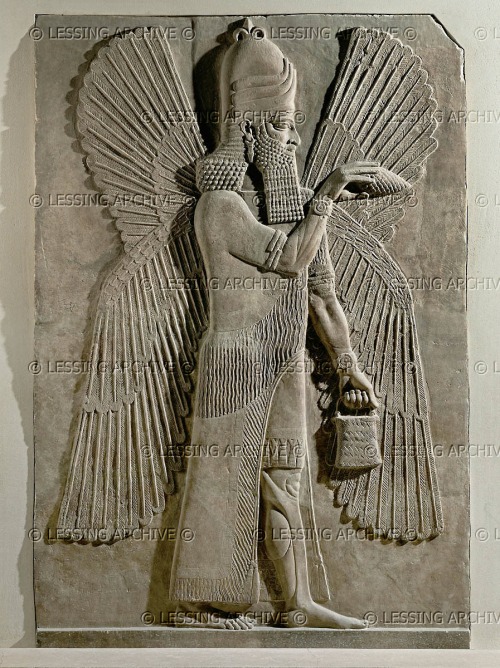Kvanvig: The Apkallus as Protective Spirits
“The apkallus are especially known from two incantation rituals: the one is Bīt Mēseri, as already stated; the other is called: šēp lemutti ina bit amēli parāsu, “to block the foot of evil into a man’s house” (KAR 298).
The two incantation series have a different scope. Bīt Mēseri prescribes the procedures to be performed when someone is ill, i.e. has come under demonic attack. Šēp Lemutti (“The Foot of Evil”) describes the procedures to be performed when a house should be protected from demonic attack. Consequently the rituals described have some common denominators, but also clear differences.
The rituals describe in great detail how figurines should be made of the seven apkallus. These figurines should then be addressed in an invocation to make them represent the apkallus themselves. In the case of Bīt Mēseri, where an ill person is concerned, the figurines should be arranged in the ill person’s room, close to his bed; in the case of Šēp Lemutti the figurines should be deposited in the foundation of the house.

Apotropaic figurine deposit found in room S57 of Fort Shalmaneser at Nimrud. Adapted from Curtis and Read (1995:112). (From Nakamura).
We are here at a point where textual and archeological evidence support one another. An abundance of such small figurines are found in boxes buried in the foundations of houses and palaces from the Neo-Assyrian and the Neo-Babylonian period.

Nakamura: “By burying figurines of powerful beings, the āšipu preserves an expressed belief in a present reality of supernatural power, mythological origin and divine order.”
Because of the detailed description of their appearance in the rituals, it is not difficult to identify the excavated figurines as the same entities described in the rituals. The excavated figurines are representations of the seven apkallus.
(Cf. F.A.M. Wiggermann, “Mischwesen A,” Reallexikon der Assyriologie und Vorderasiatischen Archäologie (RLA) 8, Berlin, 1993-7, pp. 222-25, 222, 224.)
Moreover, having identified the small figurines, it is also possible to identify many of the large reliefs that flanked the entrances to the palaces of the Neo-Assyrian kings. Here the small figurines were blown up in large scale representations of figures with the same appearance as the small figurines, corresponding to the descriptions in the rituals.
(Cf. For a detailed examination of the evidence, Dieter Kolbe, Die Reliefprogramme religiös-mythologischen Characters in neu-assyrischen Palästen, EH, Reihe 38, Frankfurt am Main, 1981, III-VII, 14-30.)

The three types of apkallū are portrayed, with the human ummânū at far left, the Nisroc bird-apkallū type in the middle, and the antediluvian purādu-fish type at far right.
The human ummânū is attested in the Uruk List of Kings and Sages, while other references to bird-apkallū are legion, as documented in Wiggermann and other authorities.
The purādu-fish apkallū is principally attested in Berossus, though other authorities confirm them, as well.
The anthropomorphic qualities of the purādu-fish and the Nisroc apkallu remain unexplained, though the eagle is sacred to Enki / Ea.
There are three kinds of apkallus: fish-apkallus, bird-apkallus, and human apkallus. The fish-apkallu is represented as a fish-garbed figure, with a human body and a carp cloak (cf. the description in Berossos).
The bird-apkallu is represented as a griffin; he has a human body, wings and a bird’s head.

A bas relief in the Louvre.
In this case the bird-apkallū tends to a sacred tree. Considering the mullilu in his right hand and the banduddu in his left, (tree cone and water bucket), he is engaged in a water ritual intended to sanctify the sacred tree. This is a common motif in Sumerian and Neo-Assyrian idols.
This bas relief is in the Louvre.
Primary publication Nimrud NW Palace I-24 = RIMA 2.0.101.023, ex. 189 (f)
Collection Nimrud, Iraq (a); British Museum, London, UK (b); Louvre Museum, Paris, France (c); Nimrud, Iraq (d); Detroit Institute of Arts, Detroit, Michigan, USA (e); British Museum, London, UK; Louvre Museum, Paris, France
Museum no. Nimrud fragment no. 42 (a); BM 098061 (b); AO 22198 (c); Nimrud fragment no. 43 and 45 (d); DIA 47.181 (e) (photo: DIA); AO 19849
Accession no. 1903-10-10, 0002 (b)
Provenience Kalhu (mod. Nimrud)
Period Neo-Assyrian (ca. 911-612 BC)
(Cf. Anthony Green, “Mischwesen B,” Reallexikon der Assyriologie und Vorderasiatischen Archäologie (RLA) 8, Berlin, 1993-7, pp. 246-64, 252; Anthony Green, “Neo-Assyrian Apotropaic Figures,” Iraq 45, 1983, pp. 87-96.)
The representation of the human apkallu is more uncertain. A. Green suggests that these apkallus were imagined as genii, figures with human bodies and wings, holding a bucket in the one hand and a cone in the other.

Now compare this Nimrud bas relief from the Louvre: an ummânū sprinkles water with a mullilu cone in his right hand, holding his banduddu bucket in his left.
This ummânū wears bracelets with a concentric circular design, and rosettes are not apparent.
This ummânū also wears the common horned headdress of Anu, but with three stacked layers of horns.
As noted elsewhere, this headdress is surmounted by an object that resembles a partial fleur de lis.
From Nimrud, capital of king Ashurnarzipal.
Louvre, AO 19845
Figures of fish-apkallus and bird-apkallus are found in Babylonian Ur and in several of the major Assyrian cities, Nimrud, Aššur and Nineveh. They are found in royal palaces and in houses assumed to belong to the guild of the āšipū, “exorcists.”

This depiction of a fish-apkallū of the purādu-fish type guarded the entrance to the temple of Ninurta at Nimrud.
A fish’s head can be seen on the Apkallu’s head, and its skin hangs down over the back of his body.
It is important to recall that the so-called Seven Sages of Sumeria were apkallū of this type.
Neo-Assyrian era, 865-860 BCE.
From the Temple of Ninurta, Nimrud (ancient Kalhu; Biblical Calah), northern Mesopotamia, Iraq. (The British Museum, London).
Osama Shukir Muhammed Amin FRCP (Glasg)
http://www.ancient.eu/image/2708/
(Cf. Dessa Rittig, Assyrisch-babylonische Kleinplastik magischer Bedeutung vom 13.-6. Jh. v. Chr., MVS. München, 1977, pp. 70-85, and pictures 20-31.)
The apkallus were, as stated, not only manufactured as prophylactic figurines. It is possible to find them in numerous examples of monumental art in Assyrian palaces. The fish-apkallu is also found in Persian Persagadae, placed at the entrance to the Audience Hall.
(Cf. Trudy S. Kawami, “A Possible Source for the Sculptures of the Audience Hall, Pasargadae,” Iran 10, 1972, pp. 146-8.)

In this bas relief from Nimrud, human apkallū, the ummánū, kneel and tend to a sacred tree.
Both ummânū wear horned tiaras and display rosette bracelets on their wrists. Bracelets are also apparent on their upper arms.
In the lower register, bird-apkallū raise mulillu cones to sprinkle water in a gesture of exorcism and liberation of sin.
As is typical, the banduddu buckets are in their left hands.
Interestingly in this case, the bracelets of the bird-apkallū are atypical. No rosettes are apparent.
In the Assyrian palaces the apkallus are guarding the sacred tree, the king, and deities. Thus the apkallus were not only invisible present in rituals (sic); they were manufactured as figures and represented in impressive monumental art.”
Helge Kvanvig, Primeval History: Babylonian, Biblical, and Enochic: An Intertextual Reading, Brill, 2011, pp. 129-31.
